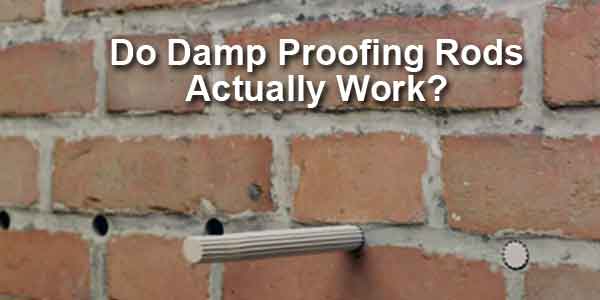The DIY Fix is reader supported. When you buy after clicking a link on our site, we may earn an affiliate commission.

Described as the ‘next generation’ treatment for rising damp, damp proof rods have grown in popularity recently. Studies show that damp proofing rods have become the go-to method for DPC delivery. So, what’s behind the trend? Why have damp proof rods become so popular? And do they work?
Not only do damp proof rods work, but they also provide a better, (and quicker) result than other rising damp treatments on the market. With a fast installation speed and a no mess, no fuss approach, damp proof rods ensure the ideal dose of active DPC ingredient is injected into a wall.
Online reviews may not be the be-all-and-end-all. However, they are a good indicator. And when 75% of Amazon reviews award 5 stars, you know you’re onto a good thing. As one reviewer says, damp proof rods are “easy to fit for any DIY’er.”
How Do Damp Proof Rods Work?
With such a resounding vote of confidence in the performance of damp proof rods, maybe we should shift the focus, from whether they work or not, to how they work.
The rods create a solid barrier to rising damp. Not only do they minimise the amount of moisture present in the wall, but the rods also block the potential build-up of ground salts. At the same time, damp proof rods also maintain heat in the wall.
The active-ingredient and water repellent contained within each rod, carefully spreads the correct dosage into the wall. As a result, when it bonds with the mortar, a lasting solution to the problem of rising damp is delivered.
What Conditions Can You Use Damp Proof Rods In?
The good news is that damp proof rods can be installed in pretty much all conditions. Even with heavily saturated walls (as much as 95%), damp proof rods will be effective.
Similarly, with both low and high alkalinity mortar, or low and high porosity mortar, the rods will still deliver the goods.
It also doesn’t matter whether the mortar is lime-based or cement-based.
The thickness of a wall shouldn’t be an issue. Damp proof rods are ideal for use with a standard thickness wall – 9” double-skin brick. However, should you be dealing with a wall thicker than 9”, you can simply combine two rods into each hole. Here, it is just a case of cutting the second rod down to any space left over by the initial rod.
Finally, damp proof rods can be installed into both warm and cold walls. Indeed, they will even be effective in freezing conditions.
How Do You Apply Damp Proof Rods?
For the confident DIY enthusiast, installing damp proof rods should not present any real problems. However, it is important to remember that any DIY damp proofing project comes with a caveat.
The effectiveness of the DPC, will be dependent on how accurately the damp proof rods are installed. Having said that, to all but the DIY novice, the installation of damp proof rods should not require the services of a professional.
Start by drilling your holes. Using a 12mm drill bit, find the lowest horizontal mortar course. Next drill holes at 120mm intervals. As you approach the final 40mm of intended depth, release the pressure you are applying on the drill. Failure to do so could result in excessive pressure, which can cause damage to the other side of the wall.
After clearing any debris that remains from the hole, install the 180mm rod. This is the exact size necessary to correctly treat a conventional 9” wall. Should the wall be thinner, simply cut the rod down so that it is 10mm shorter than the total depth of the hole.
Similarly, if the wall is thicker, cut a second rod so that it is 10mm less than the excess of the first inserted rod. The rods should be fully inserted in the holes, so there is a small recess from the brick face.
Damp Proof Rods – Are they a Genuine Alternative to Creams?
Damp proof rods have emerged as a genuine alternative to even the highest quality DPC creams. Proven to be effective even in highly saturated walls, damp proof rods outperform even the best creams on the market.
A high-strength silicone cream will do the job too of course. The cream is injected into holes, that have been drilled at regular intervals along a mortar course. This forms a DPC in much the same way to damp proof rods. The cream diffuses along the course and forms breathable water-repellent protection. This prevents damp rising up the wall.
However, damp proof rods are an easier, more straightforward alternative. They are quick and easy to install and are non-hazardous too. Damp proof rods are odourless, non-caustic and solvent-free. The simple installation means there is no mess to clean up. Not only that, you only need standard tools to install damp proof rods. There is no need for any costly specialist equipment.
Recommended Damp proof rods
If you are considering damp proof rods, we highly recommend checking out Dryrod damp proofing rods on Amazon. Click here to learn more and read customer reviews

